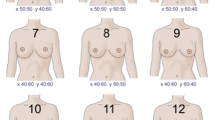Abstract
Introduction
The reconstruction of the body shape after post-bariatric surgery or high-grade gynecomastia involves, besides skin tightening, the repositioning of anatomical, apparent landmarks. The surgeon usually defines these during the preoperative planning. In particular, the positions of the nipple–areola complexes (NAC) should contribute to the gender-appropriate appearance. While in the female breast numerous methods have been developed to determine the optimal position of the NACs, there are only a few, metric and often impractical algorithms for positioning the nipples and areoles in the male. With this study, we show the accuracy of the intuitive positioning of the nipple–areola complex in men.
Material and Methods
From a pre-examined and measured quantity of 10 young and healthy men, six subjects were selected, which corresponded, on the basis of their chest and trunk dimensions, to the average of known data from the literature. The photographed frontal views were retouched in two steps. Initially, only the NACs were removed and the chest contours were left. In a second step, all contours and the navel were blurred. These pictures were submitted to resident and consultant plastic surgeons, who were asked to draw the missing NACs without any tools. The original positions of the nipples were compared with the inscriptions. Furthermore, the results were compared between the contoured and completely retouched pictures and between the residents and consultants.
Results
A total of 8 consultants and 7 residents were included. In the contoured and completely retouched images, a significant deviation of the marked positions of the missing features was found. The height of the NAC was determined somewhat more precisely than the vertical position. There was no significant difference between the contoured and completely retouched images, with a discretely more accurate tendency on the contoured images. In comparison with the professional experience, the consultants were tangentially more precise, but without a statistically significant impact.
Discussion
The intuitive determination of the NACs is a challenge for the plastic surgeon. In this study, a statistically significant deviation was seen in almost all dimensions, although the clinical relevance cannot be conclusively assessed. We found a positional relationship of the NAC to the infraclavicular groove (“Mohrenheim pit”) in the vertical and 4–4.5 cm above the submammary fold. The position of the NAC can be satisfactorily determined by a combination of plastic surgical intuition, patient wishes and practical metric methods using the Mohrenheim-Estimated-Tangential-Tracking-Line (METT-Line).
Level of Evidence V
This journal requires that authors assign a level of evidence to each article. For a full description of these Evidence-Based Medicine ratings, please refer to Table of Contents or the online Instructions to Authors www.springer.com/00266.





Similar content being viewed by others
References
Altintas MA, Vogt PM (2013) Postbariatric plastic surgery. Der Chirurg; Zeitschrift fur alle Gebiete der operativen Medizen 84:527–540
Hage JJ, van Kesteren PJ (1995) Chest-wall contouring in female-to-male transsexuals: basic considerations and review of the literature. Plast Reconstr Surg 96:386–391
Kornstein AN, Cinelli PB (1992) Inferior pedicle reduction technique for larger forms of gynecomastia. Aesthet Plast Surg 16:331–335
Wolter A, Scholz T, Diedrichson J, Liebau J (2013) Surgical treatment of gynecomastia: an algorithm. Handchirurgie, Mikrochirurgie, plastische Chirurgie : Organ der Deutschsprachigen Arbeitsgemeinschaft fur Handchirurgie : Organ der Deutschsprachigen Arbeitsgemeinschaft fur Mikrochirurgie der Peripheren Nerven und Gefasse 45:73–79
Heckmann A, Leclere FM, Vogt PM, Steiert A (2011) Surgical therapy of gynecomastia. Der Chirurg; Zeitschrift fur alle Gebiete der operativen Medizen 82(789–94):96
Tebbetts JB (2013) A process for quantifying aesthetic and functional breast surgery: I. Quantifying optimal nipple position and vertical and horizontal skin excess for mastopexy and breast reduction. Plast Reconstr Surg 132:65–73
Atiyeh BS, Hayek SN (2008) Numeric expression of aesthetics and beauty. Aesthet Plast Surg 32:209–216 (Discussion 17-9)
Beckenstein MS, Windle BH, Stroup RT Jr (1996) Anatomical parameters for nipple position and areolar diameter in males. Ann Plast Surg 36:33–36
Atiyeh BS, Dibo SA, El Chafic AH (2009) Vertical and horizontal coordinates of the nipple-areola complex position in males. Ann Plast Surg 63:499–502
Shulman O, Badani E, Wolf Y, Hauben DJ (2001) Appropriate location of the nipple-areola complex in males. Plast Reconstr Surg 108:348–351
Beer GM, Budi S, Seifert B, Morgenthaler W, Infanger M, Meyer VE (2001) Configuration and localization of the nipple-areola complex in men. Plast Reconstr Surg 108:1947–1952 (Discussion 17-9)
Stoff A, Reichenberger MA, Richter DF (2006) Male breast contouring after massive weight loss. Handchirurgie, Mikrochirurgie, plastische Chirurgie: Organ der Deutschsprachigen Arbeitsgemeinschaft fur Handchirurgie: Organ der Deutschsprachigen Arbeitsgemeinschaft fur Mikrochirurgie der Peripheren Nerven und Gefasse 38:209–216
Author information
Authors and Affiliations
Corresponding author
Ethics declarations
Conflict of interest
The authors declare that they have no conflicts of interest to disclose.
Ethical Approval
All procedures performed in studies involving human participants were in accordance with the ethical standards of the institutional research committee and with the 1964 Helsinki Declaration and its later amendments or comparable ethical standards.
Rights and permissions
About this article
Cite this article
Mett, T.R., Krezdorn, N., Luketina, R. et al. Optimal Positioning of the Nipple–Areola Complex in Men Using the Mohrenheim-Estimated-Tangential-Tracking-Line (METT-Line): An Intuitive Approach. Aesth Plast Surg 41, 1295–1302 (2017). https://doi.org/10.1007/s00266-017-0941-9
Received:
Accepted:
Published:
Issue Date:
DOI: https://doi.org/10.1007/s00266-017-0941-9




